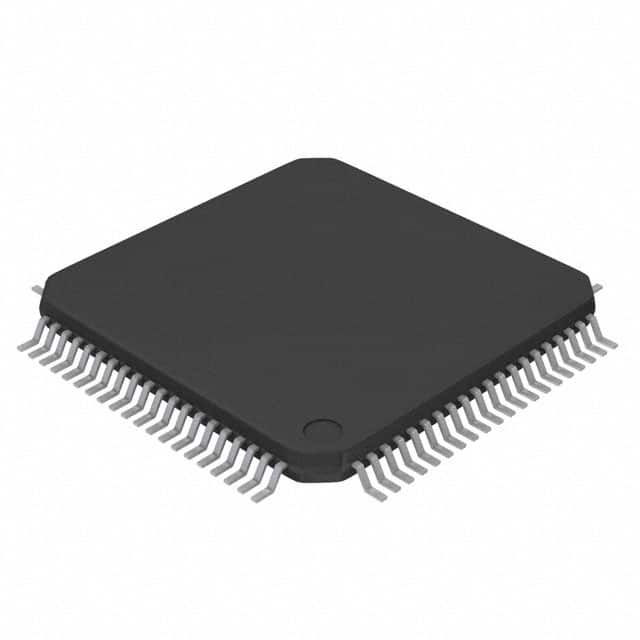A40MX04-3VQ80
Product Overview
Category
A40MX04-3VQ80 belongs to the category of Field Programmable Gate Arrays (FPGAs).
Use
This product is primarily used in digital circuit design and implementation. FPGAs provide a flexible and customizable solution for various applications, including telecommunications, automotive, aerospace, and consumer electronics.
Characteristics
- A40MX04-3VQ80 offers high-density integration, allowing for complex designs.
- It provides reconfigurability, enabling users to modify the functionality of the FPGA even after deployment.
- The package size is VQFP-80, which stands for Very Thin Quad Flat Package with 80 pins.
- The essence of this product lies in its ability to implement complex digital logic circuits using programmable interconnects and configurable logic blocks.
Packaging/Quantity
The A40MX04-3VQ80 is typically packaged individually and comes in a reel or tray packaging. The quantity per package depends on the manufacturer's specifications.
Specifications
- Logic Elements: 4,000
- Flip-Flops: 2,000
- Maximum User I/Os: 72
- Block RAM: 112 Kbits
- Maximum Frequency: 200 MHz
- Operating Voltage: 3.3V
- Package Type: VQFP-80
Detailed Pin Configuration
The A40MX04-3VQ80 has a total of 80 pins. Here is a brief overview of some important pin functions:
- VCCIO: Power supply voltage for input/output buffers.
- GND: Ground reference.
- TCK, TDI, TDO, TMS: JTAG interface pins for programming and debugging.
- IO[0:71]: General-purpose input/output pins.
- CLK: Clock input pin for synchronous operations.
- VCCINT: Internal power supply voltage for the FPGA core.
For a complete pin configuration, please refer to the manufacturer's datasheet.
Functional Features
- High-density integration allows for complex digital circuit implementation.
- Reconfigurability enables flexibility in modifying the design even after deployment.
- Support for various I/O standards and interfaces.
- On-chip memory blocks provide efficient storage for data processing.
- Dedicated clock management resources ensure reliable timing control.
Advantages and Disadvantages
Advantages
- Flexibility in design modifications.
- High-density integration capability.
- Wide range of supported I/O standards.
- Efficient on-chip memory resources.
Disadvantages
- Higher power consumption compared to fixed-function ASICs.
- Longer development time due to the need for programming and verification.
Working Principles
The A40MX04-3VQ80 FPGA operates based on the principles of configurable logic blocks (CLBs) and programmable interconnects. CLBs consist of look-up tables (LUTs), flip-flops, and multiplexers, which can be configured to implement desired logic functions. The programmable interconnects allow for flexible routing of signals between different CLBs.
During operation, the FPGA is programmed using a hardware description language (HDL) or a graphical design tool. The configuration data is then loaded into the FPGA, enabling it to function according to the specified design.
Detailed Application Field Plans
The A40MX04-3VQ80 FPGA finds applications in various fields, including:
- Telecommunications: Used in base stations, network switches, and routers for signal processing and protocol handling.
- Automotive: Employed in automotive electronics for engine control, driver assistance systems, and infotainment.
- Aerospace: Utilized in avionics systems for flight control, radar processing, and communication.
- Consumer Electronics: Found in devices like high-definition televisions, gaming consoles, and audio/video processing equipment.
Detailed and Complete Alternative Models
- A40MX04-3VQ100: Similar to A40MX04-3VQ80 but with 100 pins.
- A40MX02-3VQ80: A lower-density version of the same FPGA family with 2,000 logic elements.
- A40MX09-1PQ160: A higher-density variant with 9,000 logic elements and a different package type.
These alternative models offer varying levels of logic density and pin count to cater to different design requirements.
In conclusion, the A40MX04-3VQ80 FPGA provides high-density integration, reconfigurability, and flexibility for digital circuit design. Its applications span across telecommunications, automotive, aerospace, and consumer electronics industries. While it offers advantages such as design flexibility and efficient on-chip resources, it also has disadvantages like higher power consumption and longer development time. Nonetheless, the A40MX04-3VQ80 remains a versatile choice for implementing complex digital circuits in various applications.
10个与A40MX04-3VQ80在技术解决方案中的应用相关的常见问题及解答
Sure! Here are 10 common questions and answers related to the application of A40MX04-3VQ80 in technical solutions:
Question: What is the A40MX04-3VQ80?
Answer: The A40MX04-3VQ80 is a specific model of field-programmable gate array (FPGA) manufactured by Microsemi.Question: What are the key features of the A40MX04-3VQ80?
Answer: Some key features of the A40MX04-3VQ80 include 4,000 logic cells, 80-pin QFP package, 3.3V voltage support, and 5V tolerant I/Os.Question: In what applications can the A40MX04-3VQ80 be used?
Answer: The A40MX04-3VQ80 can be used in various applications such as telecommunications, industrial automation, medical devices, aerospace, and defense systems.Question: How can I program the A40MX04-3VQ80?
Answer: The A40MX04-3VQ80 can be programmed using hardware description languages (HDL) like VHDL or Verilog, and then synthesized and implemented using appropriate software tools provided by Microsemi.Question: Can the A40MX04-3VQ80 be reprogrammed after deployment?
Answer: Yes, the A40MX04-3VQ80 is a reprogrammable FPGA, allowing for flexibility and updates to the design even after deployment.Question: What is the maximum operating frequency of the A40MX04-3VQ80?
Answer: The maximum operating frequency of the A40MX04-3VQ80 depends on the specific design and implementation, but it can typically reach frequencies in the range of tens to hundreds of megahertz.Question: Does the A40MX04-3VQ80 support external memory interfaces?
Answer: Yes, the A40MX04-3VQ80 supports various external memory interfaces such as SDRAM, SRAM, Flash, and EEPROM, allowing for efficient data storage and retrieval.Question: Can the A40MX04-3VQ80 interface with other digital components or microcontrollers?
Answer: Yes, the A40MX04-3VQ80 can interface with other digital components or microcontrollers through its I/O pins, enabling seamless integration into larger systems.Question: What are the power requirements for the A40MX04-3VQ80?
Answer: The A40MX04-3VQ80 operates at a voltage of 3.3V and requires appropriate power supply and decoupling capacitors to ensure stable operation.Question: Are there any development boards or evaluation kits available for the A40MX04-3VQ80?
Answer: Yes, Microsemi provides development boards and evaluation kits specifically designed for the A40MX04-3VQ80, which include necessary hardware and software tools for prototyping and testing applications.
Please note that the answers provided here are general and may vary depending on specific requirements and implementation details.


